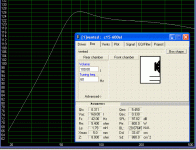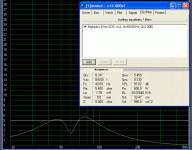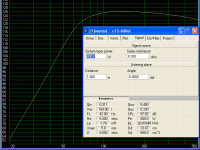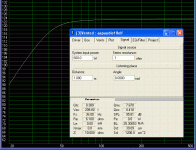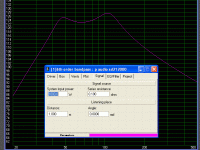The major trouble I can see with your question is that "tight" bass is a subjective description.
As already pointed out this can be a room resonance being excited, and these can be equalised out.
Another tightness that people describe seems to be what is known as "punch", this is achieved with a peak of around 6d. in the 60-80Hz. region, and is by far the most common bass characteristic found in d.j. disco type of set ups, and you will find that most of the p.a. type woofers from people like eminence are optimised for this.
The most bass from the least space is the thing that mobile p.a. d.j. people want and this is given by the filter assisted QB5 alignments.
One I worked on recently is bellow and uses a p. audio driver.
As you can see this can just exceed its cone excursion limit with 150 Watts, and produce peak outputs of 126 db. at the peak.
rcw
As already pointed out this can be a room resonance being excited, and these can be equalised out.
Another tightness that people describe seems to be what is known as "punch", this is achieved with a peak of around 6d. in the 60-80Hz. region, and is by far the most common bass characteristic found in d.j. disco type of set ups, and you will find that most of the p.a. type woofers from people like eminence are optimised for this.
The most bass from the least space is the thing that mobile p.a. d.j. people want and this is given by the filter assisted QB5 alignments.
One I worked on recently is bellow and uses a p. audio driver.
As you can see this can just exceed its cone excursion limit with 150 Watts, and produce peak outputs of 126 db. at the peak.
rcw
Attachments
I don't think this methodology is popular currently or has been for quite some time in mobile DJ or installed audio subwoofer design.
This is not a subwoofer but a currant design for a pole box.
With a different filter it can put out more sound and can be used with a sub-woofer, in this mode it is a QB5 II box.
rcw
With a different filter it can put out more sound and can be used with a sub-woofer, in this mode it is a QB5 II box.
rcw
60-80hz punch region, myth or fact ?
might just be a huge mistake or misunderstanding to think 60-80hz is all you need, if punch is all you want
does not automaticly imply you can just ignore whats below, and get away with it
I bet it goes wack, and you loose it all, that way
but it means that you might get away nicely with a closed design, and have the tight bass you want 🙄
might just be a huge mistake or misunderstanding to think 60-80hz is all you need, if punch is all you want
does not automaticly imply you can just ignore whats below, and get away with it
I bet it goes wack, and you loose it all, that way
but it means that you might get away nicely with a closed design, and have the tight bass you want 🙄
People in the business have been doing it since the 70's that I know of, and the popular "pro" drivers you get are optimised for it.
Any lower takes up far more space and uses far more power and costs much more money, and if you are in the business this matters because of the size of the vehicle you need and how many extra hands you might need to employ.
This what people I know in the business tell me and although there is demand for an extra bottom octave these days most people can't actually notice it.
Bellow is the same box as i described before used as a pole mounted satellite with a subwoofer this is achieved by just adjusting the active filter and it now can handle over 400 Watts and put out 126db. from around 100Hz.
rcw
Any lower takes up far more space and uses far more power and costs much more money, and if you are in the business this matters because of the size of the vehicle you need and how many extra hands you might need to employ.
This what people I know in the business tell me and although there is demand for an extra bottom octave these days most people can't actually notice it.
Bellow is the same box as i described before used as a pole mounted satellite with a subwoofer this is achieved by just adjusting the active filter and it now can handle over 400 Watts and put out 126db. from around 100Hz.
rcw
Attachments
.... and can be used with a sub-woofer.....
different story then
edit.....
ehh, a pro sub is what ? 40-50hz ?
People in the business have been doing it since the 70's that I know of, and the popular "pro" drivers you get are optimised for it.
Any lower takes up far more space and uses far more power and costs much more money, and if you are in the business this matters because of the size of the vehicle you need and how many extra hands you might need to employ.
This what people I know in the business tell me and although there is demand for an extra bottom octave these days most people can't actually notice it.
Bellow is the same box as i described before used as a pole mounted satellite with a subwoofer this is achieved by just adjusting the active filter and it now can handle over 400 Watts and put out 126db. from around 100Hz.
rcw
You must not be referring to modern day techno, download some Victor Calderone podcasts and high pAss at 80hz, then listen with no high pass. Doesn't even sound remotely similar!
A professional uses a sub designed for the frequency response of the playback material and makes compromises on a cost vs. benefits scale.different story then
edit.....
ehh, a pro sub is what ? 40-50hz ?
The pros doing sound for a sell out stadium tour can afford to make less compromises than a pro servicing regional support for "B or C" grade artists in small halls and clubs.
While the EV MT4 systems of the 1980's seemed adequate with about a 45 Hz F3, I'd say 35 Hz is now the "pro" LF to shoot for, there is just way more LF in most pop recordings now than when LF was limited by the vinyl recording medium popular back then.
Art
for a couple of years there have been a few producing big pro woofers with low Fs around 25hz
looks like most of the latest big woofers have Fs above 30hz
I guess its about more SPL
and sturdy stable function with stiff double spider etc
and you might want big magnet and lowish Qts, to have optimal control at very high SPL
means system ressonance is going further upwards, again
looks like most of the latest big woofers have Fs above 30hz
I guess its about more SPL
and sturdy stable function with stiff double spider etc
and you might want big magnet and lowish Qts, to have optimal control at very high SPL
means system ressonance is going further upwards, again
for a couple of years there have been a few producing big pro woofers with low Fs around 25hz
looks like most of the latest big woofers have Fs above 30hz
I guess its about more SPL
and sturdy stable function with stiff double spider etc
and you might want big magnet and lowish Qts, to have optimal control at very high SPL
means system ressonance is going further upwards, again
Manufactures usually design large woofers based on what the majority wants. As you know there is some that want to house an 18-inch woofer in a very small box. For those that are willing to use a large box to get down really low, they will find themselves searching for the appropriate driver.
As my preference is large cabinets for bass, I fall into that category of evaluating all aspects of the TS Parameters to find woofers that are not optimised for small boxes.
A Thai company called P. Audio has gained a good reputation here in Oz, .for making rugged good value for money drivers
Bellow is a design for their twenty one inch diameter woofer with a six inch voice coil.
The bandpass design increases the driver efficiency enough so that one of them can put out about as much spl as two in reflex boxes.
rcw
Bellow is a design for their twenty one inch diameter woofer with a six inch voice coil.
The bandpass design increases the driver efficiency enough so that one of them can put out about as much spl as two in reflex boxes.
rcw
Attachments
Manufactures usually design large woofers based on what the majority wants.
no, for pro drivers especially, I think they design for what works best with any given situation/condition
you might be more right with regards to hifi drivers
As you know there is some that want to house an 18-inch woofer in a very small box.
not sure a box for a 21" will ever be small for home use
no, for pro drivers especially, I think they design for what works best with any given situation/condition
you might be more right with regards to hifi drivers
not sure a box for a 21" will ever be small for home use
My comments are not based on home audio. They are based on Pro Audio.
The last time I delt with home audio was 1988. 😀
tight sound comes mostly from the frequency response. for this really dry sound you want a woofer that does not play much lower than 50hz and has a slightly rising response, so it is louder at 150hz than at 50hz. also, it may not have huge irregularities like bumps in its response. this is easily done with closed boxes since thats about their natural response. with reflex, you need to be attentive that the low end isnt bumped up, making the sound boomy.
you might also try to experiment with proper bass traps and/or nearfield placement of the speakers for the better direct/ambient soundfield ratio.
How big of a bump do you consider boomy, MaVo? Would a 2 dB bump make it boomy?
- Home
- Loudspeakers
- Subwoofers
- Building a ported subwoofer with tight bass ... how??
